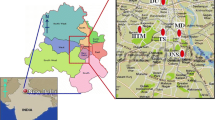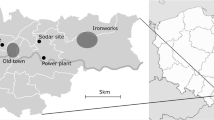Abstract
As part of the second Arctic Gas and Aerosol Sampling Program (AGASP II) continuous measurements of atmospheric aerosol black carbon (BC) were made at the NOAA/GMCC observatory at Barrow, Alaska (71°19′N, 156°36′W) during the period March 21–April 22, 1986. Black carbon is produced only by incomplete combustion of carbonaceous materials and so is a particularly useful atmospheric indicator of anthropogenic activities. The BC data have been analyzed together with the concurrent measurements of carbon dioxide (CO2), methane (CH4), and condensation nuclei (CN) that are routinely made at the observatory. All four species showed elevated and highly variable concentrations due to local human activities, principally in the township of Barrow, 7 km to the southwest, and at the DEW Line radar installation 1 km to the northwest. We distinguish between those periods of the record that are affected by local activities and those that are not, on the basis of the short-term (periods of up to 1 hour) variability of the continuous CO2 and CN records, with large short-term variabilities indicating local sources. We identified seven periods of time (events) with durations ranging from 13 to 37 hours when the BC, CO2, and CH4 concentrations changed smoothly over time, were highly correlated with each other, and were not influenced by local activities. These events had BC/CO2 ratios in the range (50–103)×10−6. These ratios are dimensionless since we convert the CO2 concentrations to units of ng m−3 of carbon. Such values of BC/CO2 are characteristic of the combustion effluent from large installations burning heavy fuel oil or coal, automobiles, and domestic-scale natural gas usage. We conclude that these events are indicative of air masses that have been polluted with combustion emissions in a distant location and then transported to the Arctic. In the absence of species-selective loss mechanisms, these air masses will maintain their combustion effluent signatures during the transport. The BC/CO2 ratios found for the local combustion activities are consistent with those expected from known combustion processes.
Similar content being viewed by others
References
Bevington, P.R., 1969, Data Reduction and Error Analysis for the Physical Sciences, McGraw-Hill, New York.
Bodhaine, B.A., Harris, J.M., and Herbert, G.A., 1981, Aerosol light scattering and condensation nuclei measurements at Barrow, Alaska, Atmos. Environ. 15, 1375–1389.
Bodhaine, B.A., Dutton, E.G., DeLuisi, J.J., Herbert, G.A., Shaw, G.E., and Hansen, A.D.A., 1989, Surface aerosol measurements at Barrow during AGASP-II, J. Atmos. Chem. (this issue).
Conway, T.J. and Steele, L.P., 1989, Carbon dioxide and methane in the Arctic atmosphere, J. Atmos. Chem. (this issue).
Halter, B.C., Harris, J.M., and Rahn, K.A., 1985, A study of winter variability in carbon dioxide and Arctic haze aerosols at Barrow, Alaska, Atmos. Environ. 19, 2033–2037.
Hansen, A.D.A., Benner, W.H., and Novakov, T., 1978, A carbon and lead emission inventory for the greater San Francisco Bay area, In: Atmospheric Aerosol Research Annual Report, 1977–1978, Lawrence Berkeley Laboratory report LBL-8696, Berkeley, California, 126–131.
Hansen, A.D.A., and Rosen, H., 1984, Vertical distributions of particulate carbon, sulfur, and bromine in the Arctic haze and comparison with ground-level measurements at Barrow, Alaska, Geophys. Res. Lett. 11, 381–384.
Hansen, A.D.A., Rosen, H., and Novakov, T., 1982, Real-time measurement of the absorption coefficient of aerosol particles, Appl. Opt. 21, 3060–3062.
Khalil, M.A.K. and Rasmussen, R.A., 1984, Statistical analysis of trace gases in Arctic haze, Geophys. Res. Lett. 11, 437–440.
Komhyr, W.D., 1983, An aerosol and gas sampling apparatus for remote observatory use, J. Geophys. Res. 88, 3913–3918.
Maring, H.B., 1985, The impact of atmospheric aerosols on trace metal chemistry in open ocean surface seawater, Ph.D. Dissertation, Univ. of Rhode Island, Kingston, Rhode Island, 140 pp.
Marland, G., Rotty, R.M., and Treat, N.L., 1985, CO2 from fossil fuel burning: global distribution of emissions, Tellus 37B, 243–258.
National Research Council, 1984, Global Tropospheric Chemistry, a Plan for Action, National Academy Press, Washington, D.C., 194 pp.
Peterson, J.T., Komhyr, W.D., Harris, T.B., and Waterman, L.S., 1982, Atmospheric carbon dioxide measurements at Barrow, Alaska, 1973–1979, Tellus 34, 166–175.
Peterson, J.T., Komhyr, W.D., Waterman, L.S., Gammon, R.H., Thoning, K.W., and Conway, T.J., 1986, Atmospheric CO2 variations at Barrow, Alaska, 1973–1982, J. Atmos. Chem. 4, 491–510.
Porch, W.M. and MacCracken, M.C., 1982, Parametric study of the effects of Arctic soot on solar radiation, Atmos. Environ. 16, 1365–1371.
Prinn, R.G., 1985, On the feasibility of quantitative analysis of atmospheric OH by titration, Geophys. Res. Lett. 12, 597–600.
Rahn, K.A. and McCaffrey, R.J., 1980, On the origin and transport of the winter Arctic aerosol, Ann. N.Y. Acad. Sci. 388, 486–503.
Ramanathan, V., Cicerone, R.J., Singh, H.G., and Kichl, J.T., 1985, Trace gas trends and their potential role in climate change, J. Geophys. Res. 90, 5547–5566.
Rosen, H. and Hansen, A.D.A., 1984, Role of combustion-generated carbon particles in the absorption of solar radiation in the Arctic haze, Geophys. Res. Lett. 11, 461–464.
Rosen, H. and Hansen, A.D.A., 1985, Estimates of springtime soot and sulfur fluxes entering the Arctic troposphere: implications to the source regions, Atmos. Environ. 19, 2203–2207.
Rosen, H., Hansen, A.D.A., Gundel, L., and Novakov, T., 1978, Identification of the optically absorbing component in urban aerosols, Appl. Opt. 17, 3859–3861.
Rosen, H., Novakov, T., and Bodhaine, B.A., 1981, Soot in the Arctic, Atmos. Environ. 15, 1371–1374.
Sadler, M., Charlson, R.J., Rosen, H., and Novakov, T., 1981, An intercomparison of the integrating plate and the laser transmission methods for determination of aerosol absorption coefficients, Atmos. Environ. 15, 1265–1268.
Author information
Authors and Affiliations
Rights and permissions
About this article
Cite this article
Hansen, A.D.A., Conway, T.J., Strele, L.P. et al. Correlations among combustion effluent species at Barrow, Alaska: Aerosol black carbon, carbon dioxide, and methane. J Atmos Chem 9, 283–299 (1989). https://doi.org/10.1007/BF00052838
Received:
Issue Date:
DOI: https://doi.org/10.1007/BF00052838




